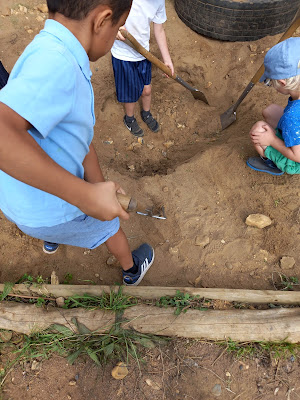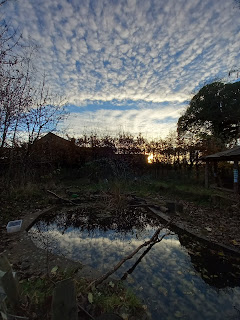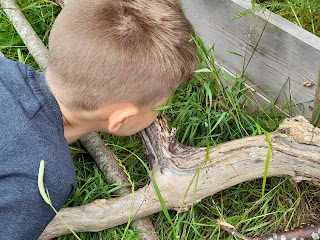I know that for many Forest School Leaders there is pressure to provide a Lesson Plan or Learning Intention for every session, especially so when you are school-based. Some FSLs are expected to deliver parts of the curriculum during sessions and others are seen as an extension to PE Provision.
Once upon a time schools chose to have Forest School provision based on its ethos and proven pedagogy, some choosing to solely aim at the children who in theory would benefit most, others used it in termly blocks for specific year groups, many embedded it into their EYFS. Early Years has the most flexible curriculum and timetable it seems.Over time Forest School has evolved differently in every setting. I'm always pointing out that the space, environment, time allocated, staffing, personal skills, and equipment we have alters how we as individuals practice. How I deliver Forest School at Chartham with 9 acres of land to choose from, and to all year groups, is not how I previously ran sessions for EYFS in a small area of trees. Neither is better. We just have to tailor what we can realistically achieve based on the children, the place, and the support.
In all honesty for me, the biggest difference is always the support. From parents, from staff, and from School Leadership.
If the adults involved in children attending Forest School are supportive the rest is relatively easy! The understanding that FS is not a subject or a topic, that it's not an extension of inside, that it has its own aims, and a specific method, makes it all the more powerful as a tool to enable children. There are skills that we 'teach' in Forest School, but not to those who are not interested. The opportunity is there and they will be encouraged to join in, and in my experience almost all children do. That is because we repeat these skills regularly, and revisit them on different levels with different age groups, as the children's skills grow, but if it were a one-off lesson with a specific aim... I can guarantee not all children would complete it.
For instance, at Forest School the equipment and resources for Bird Spotting are the same from EYFS through to Year 6:
- binoculars
- bird spotter books at several child levels and adult
- laminated bird ID sheets
- found feathers
- found eggs
- egg ID sheets
- feather ID sheets
- toy birds who make the correct sound to listen to
These are replaced and updated and added to as and when required, but the range of info remains the same, as does the equipment. The children are shown how to use the information and the binoculars correctly, starting with the right way round!
They are shown how to use the focus, to stay safe and not to climb with a strap around their neck. They use the ID sheets and books as reference. Every child will access this as and when they need to/want to and on whatever level they need. If an adult isn't present usually a fellow pupil will demonstrate and give good advice.
I can honestly say that most of Reception Class use the binoculars as necklaces, hold them too far from their face to see anything, only look at each other when they do, and love to use them to make their peers look really small!
That experience slowly becomes more focused in many ways! They ask or figure out how to make the tool more useful for seeing far away. They look more closely at distant objects, they work out which pair they prefer, they realise the need to move slowly and to look around for a 'target' to zoom in on. They adjust to keeping still, to listening for bird noises as a clue of where to aim the binoculars.
They eventually get quicker at aiming their gaze in the right direction, with and without the equipment, and even manage to track birds in flight.
These skills may be in honed by the end of Reception year. It may take till Year 6. It will depend on the opportunities that arise that they choose to engage with.
To have 'Correct Use of Binoculars' as a Learning Intention would mean the same LI every week for 7 years! And it kind of is, but it has no lesson plan that the children must follow!
This week one of the children's favourite activities: digging, quietly evolved in the dig pit. It started on Monday with Year 6 class aiming to dig as deep as they could. Our soil is a mix of flint and clay, but decades ago a rabbit warren was filled in with sand and so we hit seams of easy-dig sandy soil. The combination of all three means it can be a tough dig but will reward the excavator with putty-like clay and amazing shapes of flint. Children organised themselves, took turns, and worked together to make a hole about half a metre deep. Yes, they argued at times, but usually resolved it themselves, and settled to their joint task. Once the first class left, the second discovered the hole and widened it.
Younger classes discovered it over the week, in turn making it deeper or wider. Then a class decided to dig a second hole as waiting for a turn to excavate that one was taking too long. The next class along decided to make that one as deep as the first. The next day the task became to tunnel between the two. Once that was achieved the last classes to go in removed stones and 'improved' what was there.
At the start of each session, I told the newly arrived class what the last class had achieved and passed on the hopes from the previous session that it wouldn't be destroyed. Every class (twelve in total) worked on it as an ongoing project with no direction except to respect the work of the previous group.
They observed and planned, discussed and cooperated, helped each other and made great teams. They considered the feelings of others and were mindful of the space and achievements of those who had worked before them.
Across the whole week, without ever being together as a 12-class group, the school collaborated on a self-chosen task that evolved from a flat dig pit into a bridge and tunnel.
That initial idea was passed on and evolved into a feat of engineering that children aged 5 through to eleven were able to participate in.
It's not a Learning Intention I would ever have thought of planning.
It's not on the curriculum.
But the skills demonstrated as well as the emotional intelligence involved are not only transferable into other lessons, but into life.
And THAT is what Forest School is here to 'teach'.
.............................
NB: Our binoculars came from the BTO who ask members who upgrade their binoculars to consider donating those they no longer want. There is a form on their website where you can join a list of possible recipients.











Comments
Post a Comment